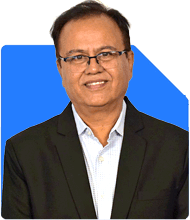I am 25 years old, earning 1.2 lakhs per month. My monthly expenses are around 35-40 k. I have a mutual fund portfolio of 20 Lakhs (mostly equity based) and gold 5 lakhs. I want to retire by 40. My parents have rental income and income from FD. Is it possible for me to retire by 40? What is a decent amount required for me to retire?
Ans: Retiring by 40 is an ambitious and commendable goal. Given your current financial status and aspirations, we need to create a detailed strategy to ensure a secure and comfortable early retirement. Let's delve into various aspects to evaluate your readiness and outline the necessary steps to achieve your goal.
Understanding Your Current Financial Position
Your current monthly salary is Rs. 1.2 lakhs, with expenses ranging between Rs. 35,000 and Rs. 40,000. You have a solid mutual fund portfolio worth Rs. 20 lakhs, primarily equity-based, and gold investments valued at Rs. 5 lakhs. Your parents have rental income and FD returns, adding a layer of financial security.
These figures highlight a robust starting point for your retirement planning. Your substantial investments and controlled expenses form a strong foundation.
Estimating Retirement Corpus
To determine the corpus needed for retirement by 40, we must consider several factors:
Monthly Expenses: Estimate post-retirement expenses considering inflation.
Lifestyle: Consider your desired lifestyle and any additional costs, like travel or hobbies.
Healthcare: Anticipate healthcare costs, which typically rise with age.
Longevity: Plan for a long retirement, assuming a lifespan of 85-90 years.
With current expenses at Rs. 35,000 to Rs. 40,000, let's assume an average monthly expense of Rs. 37,500. Considering inflation, your expenses will grow over time. For simplicity, assume an inflation rate of 6% per year.
Building a Retirement Corpus
Now, let's focus on building the required corpus. With 15 years until retirement, you need to strategically invest to accumulate the desired amount.
Equity Mutual Funds
Equity mutual funds have historically provided high returns, making them suitable for long-term growth. Your existing portfolio of Rs. 20 lakhs is a great start. Consistently investing in equity mutual funds can significantly boost your corpus.
Benefits of Actively Managed Funds
Actively managed funds offer the advantage of professional fund management. Fund managers actively select stocks and adjust portfolios to optimize returns. This can result in higher returns compared to passive funds, which simply track an index.
Investing through a Certified Financial Planner (CFP) can enhance your strategy. A CFP can guide you in selecting the best actively managed funds, ensuring your investments align with your goals and risk tolerance.
Increasing SIP Contributions
Systematic Investment Plans (SIPs) are an excellent way to invest regularly and benefit from rupee cost averaging. Currently, you have a significant investment in mutual funds. Increasing your SIP contributions will accelerate your corpus growth.
Aim to allocate a higher portion of your income towards SIPs. Given your monthly income of Rs. 1.2 lakhs and expenses of Rs. 40,000, you have a surplus of Rs. 80,000. Allocating a significant part of this surplus to SIPs can help achieve your retirement goal.
Diversifying Investments
While equity mutual funds are crucial for growth, diversifying your investments reduces risk. Consider the following options:
Gold
Your existing investment in gold (Rs. 5 lakhs) is valuable. Gold acts as a hedge against inflation and market volatility. Periodically review and adjust your gold investments based on market conditions.
Debt Mutual Funds
Debt mutual funds provide stable returns with lower risk compared to equity. Allocating a portion of your investments to debt funds ensures stability and liquidity. This balanced approach can protect your portfolio from market fluctuations.
PPF and NPS
Public Provident Fund (PPF) and National Pension System (NPS) are excellent for long-term investments. PPF offers tax benefits and guaranteed returns. NPS, with its market-linked growth, is ideal for retirement planning. Regular contributions to these schemes can enhance your retirement corpus.
Managing Risk and Ensuring Liquidity
Diversifying investments helps manage risk, but it's equally important to ensure liquidity. Emergencies can arise, and having accessible funds is crucial. Maintain an emergency fund equivalent to 6-12 months of expenses. This fund should be in a liquid asset like a savings account or a liquid mutual fund.
Evaluating Your Insurance Needs
Adequate insurance coverage is vital for financial security. Review your life and health insurance policies to ensure they meet your needs. Opt for term insurance for life coverage, as it offers high coverage at a low cost. Health insurance should cover potential medical expenses, reducing the financial burden during emergencies.
Regular Financial Review
Regularly reviewing your financial plan is essential. Life circumstances and financial markets change, necessitating adjustments to your strategy. A Certified Financial Planner can assist in periodically reviewing and rebalancing your portfolio, ensuring you stay on track.
Benefits of Professional Guidance
Working with a Certified Financial Planner offers several benefits:
Personalized Advice: CFPs provide tailored advice based on your unique financial situation and goals.
Expertise: They possess in-depth knowledge of financial markets and investment options.
Accountability: CFPs help you stay disciplined and focused on your financial goals.
Estimating Post-Retirement Income
After retiring, you’ll need a steady income stream to cover your expenses. Consider the following sources:
Systematic Withdrawal Plan (SWP)
SWP allows you to withdraw a fixed amount regularly from your mutual fund investments. This ensures a steady income while keeping the remaining corpus invested.
Rental Income
If you own property, rental income can be a reliable source of post-retirement income. It provides regular cash flow without depleting your investment corpus.
Ensuring Inflation Protection
Inflation can erode your purchasing power over time. To combat this, your investment strategy should focus on assets that outpace inflation. Equity investments, with their potential for high returns, are well-suited for this purpose. Regularly review and adjust your portfolio to ensure it remains inflation-proof.
Managing Taxes
Tax-efficient investing is crucial for maximizing returns. Utilize tax-saving instruments like PPF, NPS, and ELSS (Equity Linked Savings Scheme) to reduce your tax liability. A Certified Financial Planner can help you navigate tax laws and optimize your investment strategy.
Planning for Healthcare Costs
Healthcare expenses typically rise with age. Ensure you have adequate health insurance coverage to manage these costs. Additionally, consider setting aside a portion of your corpus specifically for healthcare. This will provide peace of mind and financial security during medical emergencies.
Legacy Planning
Planning for your legacy is an essential aspect of retirement planning. Ensure your assets are distributed according to your wishes. Creating a will and nominating beneficiaries for your investments can simplify this process. A Certified Financial Planner can guide you through estate planning, ensuring a smooth transfer of assets.
Lifestyle Considerations
Retirement is not just about financial security; it’s also about enjoying a fulfilling lifestyle. Consider your hobbies, interests, and travel plans. Allocate funds for these activities to ensure a rewarding retirement experience.
Appreciating Your Efforts
Your disciplined approach to saving and investing is commendable. Building a substantial mutual fund portfolio and gold investments at a young age demonstrates foresight and commitment. With careful planning and consistent effort, retiring by 40 is achievable.
Final Insights
Retiring by 40 is an ambitious but attainable goal with the right strategy. By focusing on high-growth investments, diversifying your portfolio, and managing risk, you can build a substantial retirement corpus. Regular reviews and professional guidance from a Certified Financial Planner will keep you on track.
Plan for a long and fulfilling retirement by considering post-retirement income sources, inflation protection, and healthcare costs. Your disciplined approach and proactive planning will pave the way for a secure and enjoyable retirement.
Best Regards,
K. Ramalingam, MBA, CFP,
Chief Financial Planner,
www.holisticinvestment.in











.jpg)













